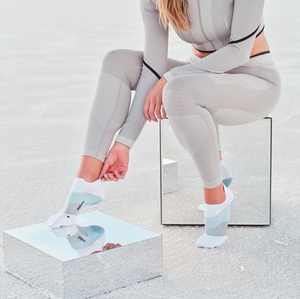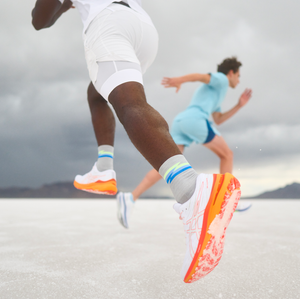Hills, ugh. #amiright?
My hill-tackling mentor is actually not a runner at all, but a skier. Daron Rahlves is a Truckee-based former World Cup downhill skier, ski-cross racer and Olympian. Each year, he puts on his own race/fundraiser at his home mountain where skiers and riders compete to see who can get top-to-bottom first. Simple, right?
I once interviewed him post race from podium (yes, he won his own competition: not fair!) and asked him what his secret was to taking down the hill.
“The key is to not get overwhelmed,” he said. “Just look at what’s right in front of you. If you step back and look all the way down, it’s going to be too much. In the back of your mind you have to anticipate what’s ahead, but in the moment, it’s just breathing and looking just a few feet ahead.”
For whatever reason, that little nugget didn’t resonate until about six months later when I was knee-deep in the pain cave mired at the first water stop of the Squaw Mountain Run. Seven thousand feet and change above sea level, my lungs were charred to an ineffective crisp and my legs were made of fusilli. With 2,000 feet yet to climb to summit at the mountain’s High Camp finish, I was pretty much done. Then, who of all people should pass by but Daron’s sister, an avid runner and triathlete who also lives in the area. Suddenly, his sentiment came back to me and I realized I could apply his philosophy as much to running up hill as flying down it.
So, I adjusted the brim of my hat, choked down some water and set my sights just a few feet in front of me. First I made it to that rock around the bend. Then to that crooked Manzanita bush. Then to that work truck stalled up there just past the bridge. Then up to and past that pair of runner’s feet tramping dust in their wake. By focusing just a little bit ahead, I found myself running again, breathing again and back in the race.
That philosophy is now a part of me and, as corny as it sounds, is one I apply to life’s more overwhelming or mundane tasks as well. Big things only get done in tiny increments and it’s only when we look back that we can—and should—take the time to examine how far we’ve journeyed up that hill.
But I’d be remiss if I pretended there wasn’t as great a physical component to running hills as there is a psychological one. So here are a handful of suggestions on what can work with form and function.
Tips on Running Hills
Remember, running is an exact science, but that science varies for every individual body:
Lean Forward (Running Uphill)
For starters, I was always told to emulate the hill’s pitch with the amount I lean forward. In other words on steep climbs hunch way over. That’s what I thought leaning in was. Turns out I was just running like Quasimodo. A friend and experienced runner once observed me doubled over for the majority of a trail climb and told me that my lean in needed to come from the hips down, and put it in a way that I finally understood. Think of yourself as a pencil angled when you’re writing. That’s your body going uphill, not exactly rigid but all of you straight and firm, pressing into that giant sheet and writing your story.
Keep Your Head Up
Lift that head up and look ahead. This is where the physical meets the psychological. Though some running guides suggest keeping the chin all the way up and looking as much as 25-30 yards ahead, I’m not really sure how realistic that is, especially taking into consideration most folks’ vision. I do try to get a good 10- to 15-yard gaze up the hill and I, as mentioned, I do use markers to cross off my invisible list. Either way, eyes ahead scanning that next little bit is essential. And, as hard as it is NOT to do, never simply stare down at your feet (they’ll be there commanding your full attention once you’re done, trust me).
Point Your Toes Forward
Keep those toes pointed as you drive knees forward. You want to try to maintain those springy legs and get as much out of your strike as you can. As dumb as it may sound, pointing your toes down like a ballerina will keep you centered on hills so you can maximize the power generated that goes up through your ankle and knee position and gives you a little extra pop. Do this and now you’re actually using the hill as leverage. It’s a difficult technique to master without thinking about it but go ahead and watch and experienced hill climber, you’ll see they appear to be on springs. With lots and lots of practice you too can harness the physics that gives the elites their extra boing.
Keep Your Body Rigid & Arms Loose (Running Downhill)
Downhill running can be just as difficult, if not more so, for some—especially those who’ve battled knee injury or joint pain. The key to running downhill is again to be that pencil (this time leaning back) and while your body is rigid, make sure your arms are loose and relaxed without being noodly. Many runners make the mistake of flapping their arms a bit on the downhill—be it for balance or just the simple relief they’re not driving up and ahead anymore. Try to avoid crazy arms, or what some people call “rolling down the windows” as it tends to steer you off your line and wastes precious momentum and time.
Your stride will extend and your pace will quicken on the downhill, but try to keep things at a comfortable and controlled clip. Much of this can be accomplished by making sure that chin is up and those eyes are focused ahead, albeit this time around those little benchmarks will come at you much faster.
Do What Works Best for You
Lastly, it’s fairly common to get discouraged when learning what works best with your body’s geometry and fitness while mastering the art of running hills. Some folks try to trick themselves into keeping the same pace uphill and even down. For me, even at my personal best, there’s always a guy who can pass me with a pair of hiking poles and a long stride. Don’t worry about it. The key is going at a pace that’s measured and approachable. I’ve often found I can hit that running hills nirvana when my heart rate actually goes down a bit. It lets me know I’m relaxed, breathing well, leaning into it with my hips and, most of all, focusing on and conquering life’s little challenges one step at a time.



Leave a comment